ISSN ONLINE(2319-8753)PRINT(2347-6710)
ISSN ONLINE(2319-8753)PRINT(2347-6710)
SubrahmanyaSwamy S.1, B. R. Sreedhar2, Vinayak J. Kalas3, Chandan K. M3, Sandeep S. H4
|
| Related article at Pubmed, Scholar Google |
Visit for more related articles at International Journal of Innovative Research in Science, Engineering and Technology
With the advent of high speed machining, to improve productivity, the dynamic performance of machine structures especially in precision machining becomes critical. Granite epoxy composite is a novel material being developed as an alternate material for precision machine tool beds. This composite consists of well-graded granite particles and Araldite resin with a suitable hardener for curing the mix at room temperature. Several distinct advantages like excellent damping properties, long term dimensional stability, less curing time leading to shortest lead time for manufacture, long term dimensional stability and lower production costs compared to conventional Cast iron beds can be derived from this composite. Objective of this study was to investigate experimentally effect of resin content on vibrational characteristics of granite epoxy composite.
Keywords |
| Granite epoxy composite, Dimensional stability, Precision machining, Vibration damping |
INTRODUCTION |
| The precision of Machine Tools and Coordinate Measuring Machines, used in metal-mechanical industry, is directly related with the materials used in their construction. One of the main elements of these equipments is its base or structure over which all other building components are supported. The materials specified for its manufacture must have high values of elastic modulus, yield strength, wear resistance and toughness due to the machine intense mechanical demands. Added to these properties, it is also desirable that these materials present reduced thermal expansion coefficient and higher damping capacity to perform their tasks with the required precision. |
| The materials currently used that meet these properties demand are cast iron and granite. However, cast iron presents high thermal expansion and conductivity, which allow errors in the manufacturing, due to dimensional changes caused by thermal expansion and contraction and structure distortions induced by the variations in the room temperature. The granite, a natural low cost ceramic, has low tenacity but is not easy to process due to its high hardness, porosity and internal cracks, making difficult the fabrication of complex geometry components. An additional choice mentioned in the literature is the use of concrete structures, but the reduced dimensional stability associated to water absorption makes its use unfeasible. |
| The high speed operation of a machine tool is important for productivity improvement. Although the cutting speed has been increased due to newly developed cutting tool materials such as ceramic, CBN, diamond and as on, productivity is still restricted by the low transfer speed of massive moving bodies which are usually made of steel and cast iron. One of the primary reasons for low productivity is large mass of the moving parts of machine tool restricts employment of high acceleration and deceleration during non-cutting periods. |
| Machine tool structures with high specific stiffness and high damping are required not only to improve the accuracy of a machine tool to obtain enhanced productivity. The high specific stiffness and good damping of machine tool structures are contradictory requirements if conventional metallic materials are employed because conventional metal have almost same low specific stiffness with low damping characteristics. Moreover, the vibration of machine tool parts is another obstacle to the high speed operation. Modern machine tools are usually equipped with high speed spindle system rotating up to 50,000 rpm and moving frames operating up to the acceleration and deceleration of 20-30 m/s2. At these high speed operations, machine tool structures are vulnerable to vibration if the structures were made of conventional metallic materials with inferior damping characteristics. |
| This work presents a study on the behaviour of the Granite Epoxy composites with and without cast iron powder subjected to vibration with different resin to aggregate ratios. Samples of particulate granite-epoxy composites were obtained with different particle size and percentage by weight of granite and different resin to hardener ratio defined as process variables. The investigation of the damping properties was conducted using the vibration impulse response method by measuring the resonant frequency. Typical FRFs were obtained for various compositions of granite epoxy with and without cast iron and cast iron. The damping ratios of the specimens were calculated by 3dB method. |
II. BACKGROUND |
| Antonio Piratelli-Filho et.al, [1] carried work on Characterization of Compression Strength of Granite-epoxy Composites Using Design of Experiments. This paper presents a processing study of the polymer matrix composite (PMC) developed with an epoxy polymeric matrix reinforced with particulate ceramic granite. This PMC composite has been reported to be used as structural parts of machine tools and Coordinate Measuring Machines due to its superior vibration damping characteristics and reduced processing cycle over cast iron. A.Selvakumar et.al, [2] carried work on Analysis of alternative composite material for high speed precision machine tool structures. Structure material plays a vital role in precision machine tools, which are expected to produce the parts within the specified accuracy of shape and dimensions together with the required surface finish. The shape of the work piece depends on the instantaneous relative position of the tool and the work piece and, therefore, of the machine parts which carry them. Hence, a structure which possesses high structural stiffness and high damping is to be selected. Composite materials such as, epoxy granite, exhibit good mechanical properties such as high stiffness and damping ratio at a lesser weight, compared to conventional materials. However, for the same stiffness, the basic dimensions of the structures vary. In this study, the mechanical characteristics of an epoxy granite beam are studied against the conventional materials such as cast iron and steel with reference to constant stiffness. It is observed that, for same stiffness, the epoxy granite structure offers a considerable weight reduction, along with high damping characteristics. Antonio Piratelli-Filho and Flamínio Levy-Neto [3] carried work on behaviour of Granite-Epoxy composite beams subjected to mechanical vibrations. The capacity to damp mechanical vibrations is one of the most important properties of granite-epoxy composites, even superior to the cast iron one. The obtained results showed that composite samples, with weight fractions of about 80% of granite and 20% of epoxy, presented damping properties approximately three times greater than gray cast iron. K.M.Lim et.al, [4] carried work on electromagnetic wave absorption properties of amorphous Alloy–Ferrite–Epoxy Composites in Quasi-Microwave Band and they reported on the electromagnetic wave absorption properties of amorphous alloy–ferrite–epoxy composites with various amorphous alloy fractions in the frequency range from 1 to 5 GHz. They varied the fraction of amorphous alloy in amorphous alloy–ferrite–epoxy composites from 0 to 50 vol.% at a fixed 50 vol.% fraction of epoxy resin polymer. They measured the complex permeability μ and permittivity of composites by the reflection/transmission technique, and determined the theoretical matching frequency and thickness with maximum reflection loss by plotting the measured μ and € on an impedance matching solution map. The increasing amorphous alloy fraction in amorphous alloy–ferrite–epoxy composites resulted in a larger matching frequency and thinner thickness than those of ferrite–epoxy composite. On the basis of these results, they proposed a new, thinner wave absorber, made by optimizing the amorphous fraction and thickness in amorphous alloy–ferrite–epoxy composites. Mr.M.Prabhakaran et.al, [5] carried work on Analysis of mechanical properties And free vibration response of composite laminates. Of all composite materials the fabric type has evoked the most interest among embedded in matrix materials to form laminated composites. In this research, they investigated free vibration and the effect of stacking sequence on tensile, impact and absorption properties of composite laminates has been investigated experimentally. Shetty Ravindra Rama et.al, [6] carried out studies on tensile, flexural, density and void content studies on Granite Powder Filled Hydroxyl Terminated Polyurethane Toughened Epoxy. Composites were developed using varying weight fractions of silane coupling agent treated granite powder as reinforcement in pure and toughened epoxy resin. Various physico-mechanical properties such as tensile and flexural behaviour, density, and void content were determined. Studies revealed that toughened resin composites enhance the properties compared to neat matrix. |
| Subrahmanya Swamy et.al, [7] have conducted several tests to determine the some of the mechanical and thermal properties of granite epoxy. Compression tests have been conducted to investigate the role of certain factors that affect the compression strength of granite epoxy and optimum levels of those factors leading to higher compressive strength of granite epoxy were determined. Granite aggregate mix composition, granite aggregate to epoxy ratio, hardener to epoxy ratio and vibration of mould during compaction were the factors considered for experimentation. Compression test results have been analyzed using ANOVA technique and the factor levels leading to higher compressive strength were established. Test specimens were cast as per the suggested optimum levels from the analysis and tested for compression. Among the different levels of factors selected, the combination of granite mix with 60% fine aggregate epoxy resin/ granite aggregate ratio of 1:7, hardener/epoxy resin ratio of 1:10 and frequency of vibration of 40Hz during compaction were found to give better results in compression. Confirmation tests have shown an average compressive strength value of around 123 MPa. The average compression modulus is found to be around 30 GPa. |
| Flexural tests have been conducted on the standard ASTM D790-92 rectangular cross-section bar with dimensions 160x40x40mm.Three samples of different standard composition were tested on UTM. Flexural strength properties of granite epoxy material for all composition were found to be around 30 to 32 MPa. Hardness tests have been conducted on the test specimens of Ø 38x56 mm size, with different composition of granite aggregate and tested for Brinell hardness. Granite epoxy material of 50% coarse 50% fine aggregate composition has shown the highest hardness of 187 BHN. Torsion test has been conducted on standard specimen of granite epoxy composites. Torque load was applied manually at low speed. Torque and the corresponding angle of twist were noted until specimen failed. The average shear strength for 50% coarse 50% fine aggregate composition was found to be the highest at 81 MPa and the average rigidity modulus for the same was found to be 1.6 GPa. |
| Tests were also conducted to determine the specific heat of granite epoxy composites. 50% fine 50% coarse composition of the granite epoxy was employed for casting the specimen. The specimen was cast in the form of the sphere. Specific heat of 50% fine + 50% coarse granite epoxy was found to be about 1356 J/Kg K which is about 3 times that of cast iron (430 J/Kg K). Thermal conductivity test was also carried out on 3 samples each having three different compositions of granite aggregate mix. The thermal conductivity of granite epoxy was found to be influenced by its composition. As the finer content of the aggregate mix was increased, the thermal conductivity of the material was found to increase. At 50% fine composition, the thermal conductivity was found to be 0.6 W/m K and at & 75% fine composition, the conductivity was found to be about 0.73 W/m K. |
III. MATERIAL AND METHODS |
| Granite epoxy composite is a novel material being developed as an alternate material for precision machine tool beds. This composite consists of well-graded granite particles and Araldite resin with a suitable hardener for curing the mix at room temperature. Several distinct advantages like excellent damping properties, long term dimensional stability, less curing time leading to shortest lead time for manufacture, long term dimensional stability and lower production costs compared to conventional cast iron beds can be derived from this composite. Mixing and bonding together carefully selected mix of correctly graded granite aggregate, epoxy resin and curing or hardening agent forms granite epoxy composite. |
| There are many factors that affect the compression strength of granite epoxy. The factors considered for experimentation were- Granite aggregate mix composition, Granite aggregate to epoxy ratio, Hardener to epoxy ratio and Vibration of mould during compaction. Varying the proportion of granite aggregate in the mixture can alter the compressive strength of epoxy concrete. Increase in granite aggregate portion in the mixture within practical limits v |
| A. Vibration Characteristics of Granite Epoxy |
| The objective of this study was to investigate experimentally the effect of granite aggregate mix composition on vibration characteristics of granite epoxy. 50x50x480 mm specimens were cast by making use of five different resin percentages for the optimised composition of granite aggregate mix (50% fine and 50% coarse) and tested for resonant frequencies and damping ratio by conducting modal analysis using FFT analyser. Specimens having resin percentage by weight 16%, 14%, 12.5%, and 11% were cast. A FG 200 cast iron specimen of the same size was also tested for resonant frequency and damping ratio. The specimens cast are shown in Fig.1. Table 1 shows the composition of 50% fine and 50 % coarse Granite aggregate. Also, Gr-Ep with cast iron specimens were cast in which had 20% fine granite aggregate (0.3 mm retained and 0.15 mm retained) by weight was replaced by fine cast iron powder of 0.075 micron particle size. |
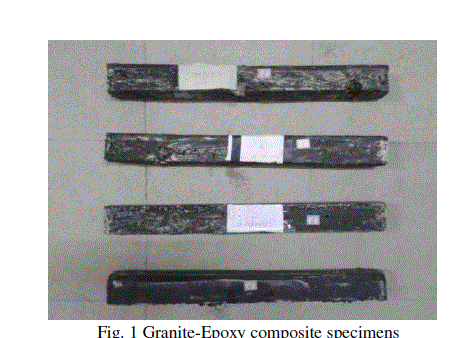 |
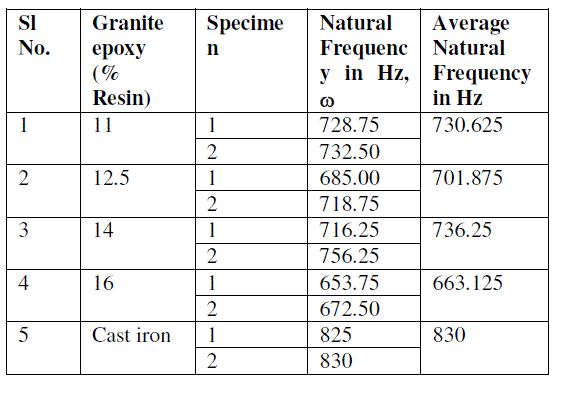 |
| Young’s modulus for various compositions was also estimated using this vibration impulse response method by measuring the resonant frequency. Typical FRFs (Frequency Response Functions) were obtained for various compositions of granite epoxy and cast iron. The damping ratios of the specimens were calculated using the by measuring the frequency interval of 3dB, where the magnitude of the vibration dropped 3 dB from that of the fundamental frequency. |
| Modal damping was estimated by using relation (1). |
 |
 |
| B. Experimental Setup |
| Through an impact experimental test, FRFs are determined. The experimental setup for conducting modal analysis is shown in Fig 2. The specimen is hung on a rigid support with a free- free boundary condition. Channel one is connected to the hammer which is used for exciting the specimen for free vibrations. Channel 2 is connected to the accelerometer which is used for measuring response of the beam. At the mid span of the specimen, accelerometer is mounted to measure acceleration. Specimen can be excited for free vibration at different points marked on the specimen and response is observed and stored. |
 |
IV. RESULTS |
| A. Granite-Epoxy Specimens: |
| The frequency response function (FRF) graphs for various Gr-Ep specimens are shown in Fig. 3(a) to 3(d) and the FRF graph of cast iron specimen is shown in Fig. 3(e). The time domain response of a few specimens is shown in Fig.4. |
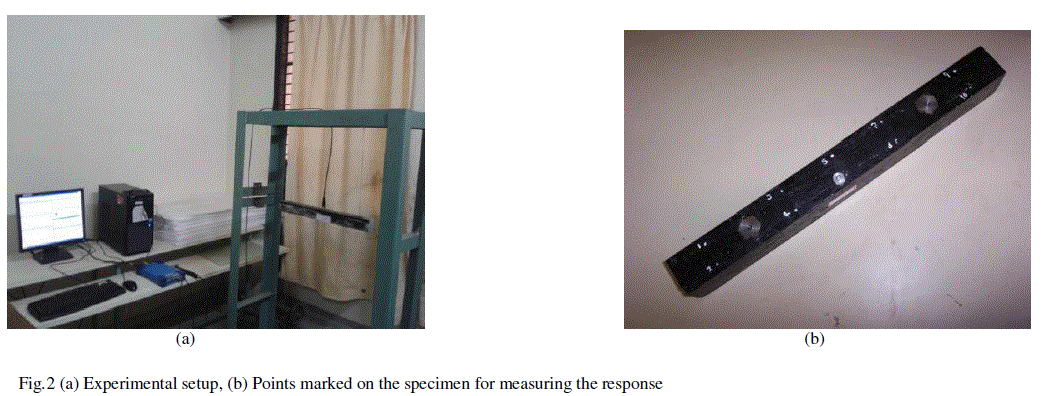 |
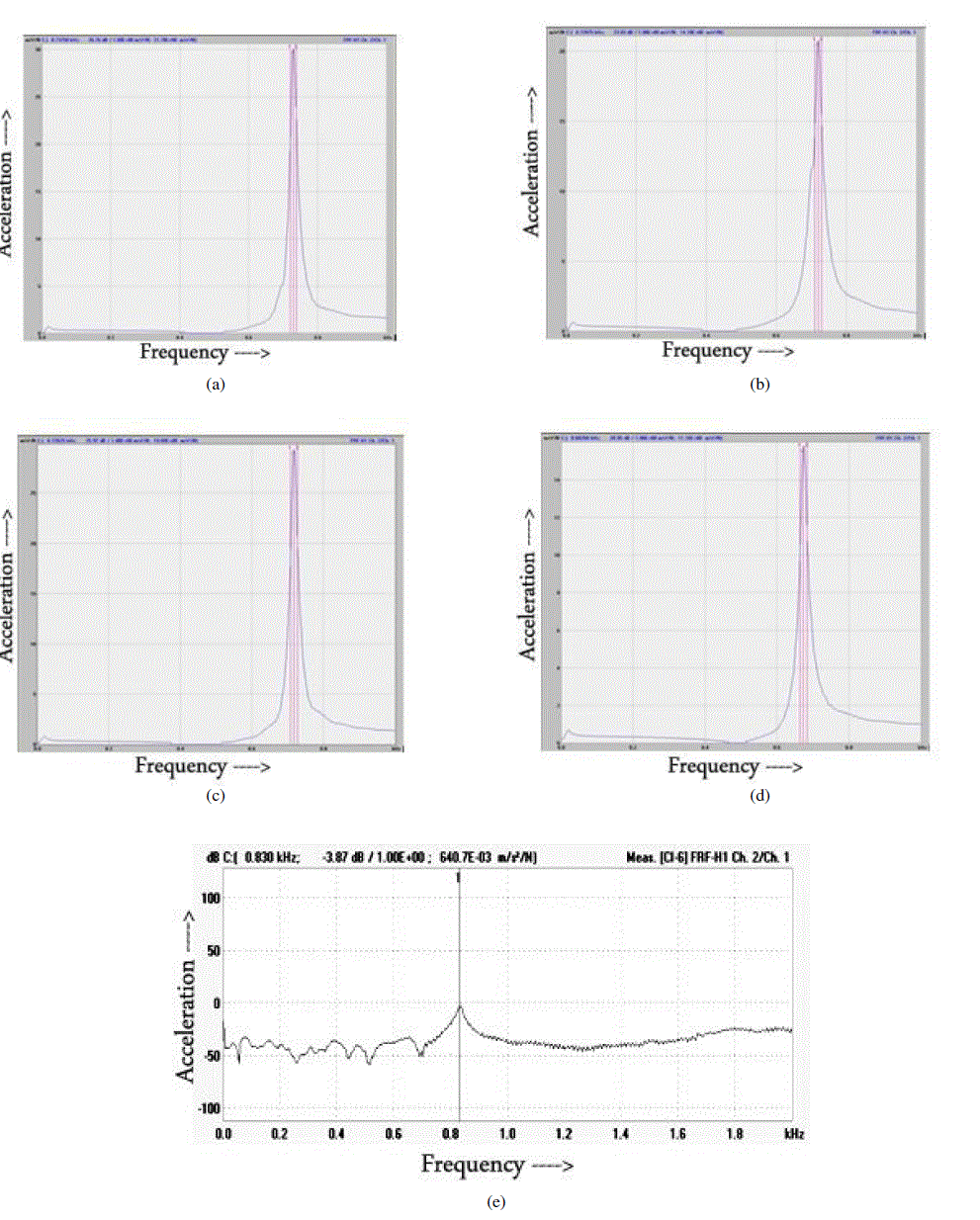 |
| The time domain response graphs of Gr-Ep specimens shown in Fig 4 shows the time taken by each specimen to damp the vibration due to the excitation given. A considerable difference is seen between the settling time for CI specimens and that for Gr-Ep specimens, indicating better damping in Gr-Ep specimens. |
| The natural frequencies of various Granite Epoxy specimens were taken from the Fig.3 (a) to Fig.3 (d) and are tabulated in table 2 (a). The modal damping average modal damping values are tabulated in table 2 (b). The Young’s modulus was calculated and tabulated in table 2 (c). |
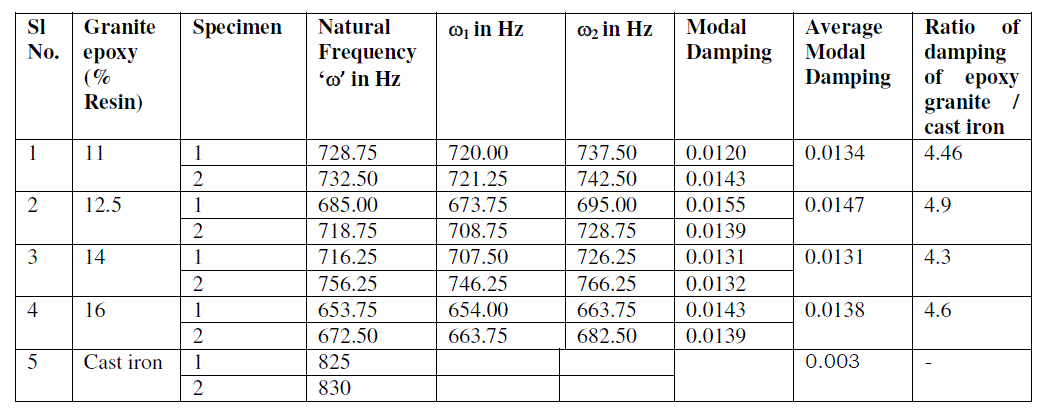 |
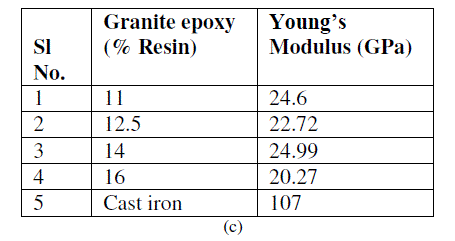 |
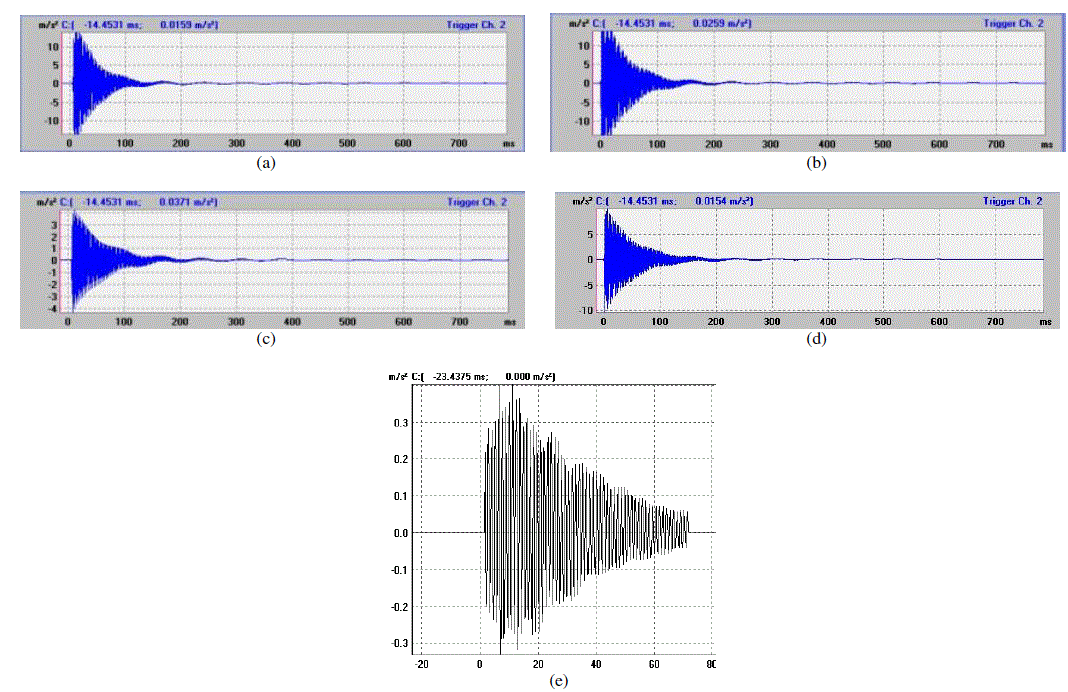 |
| B. Granite Epoxy with Cast Iron powder specimens: |
| The high damping capacity of cast iron is one of the most valuable qualities of this material. For this reason it is ideally suited for machine bases and supports, engine cylinder blocks and brake components. The damping capacity of cast iron is considerably greater than that of steel or other kinds of iron. This set of experiments was conducted to study the effect of fine CI powder of 0.075 micron size on the damping properties of Gr-Ep composites. The frequency response function graphs for various Gr-Ep with Cast Iron specimens are shown in Fig. 6(a) to 6(d). |
| The FRFs shown in Fig 6 show a considerable increase in the width of the peak and hence signifies increased damping as compared to that of Gr-Ep specimens. |
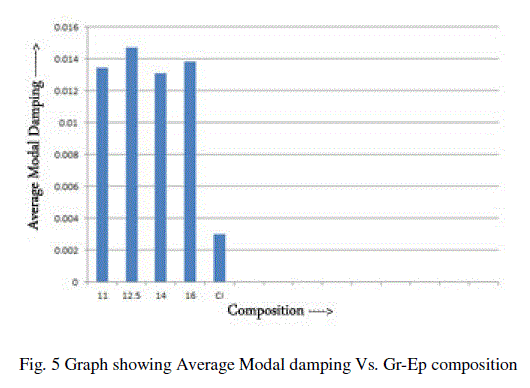 |
| The natural frequencies of various Granite Epoxy with CI powder specimens were taken from the Fig.6 (a) to Fig.6 (d) and are tabulated in table 3 (a). The modal damping average modal damping values are tabulated in table 3 (b). |
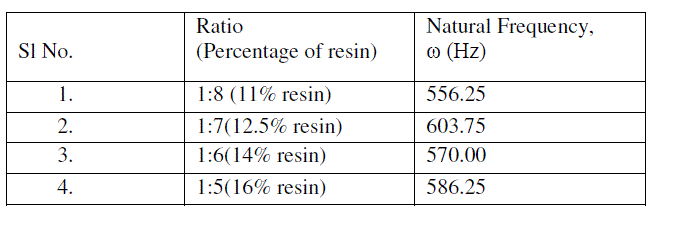 |
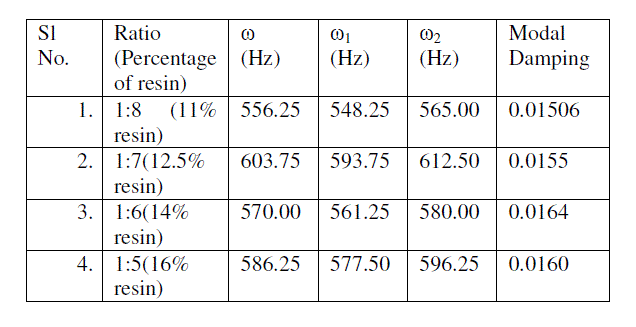 |
| Table 3 (a) Natural frequencies for Granite Epoxy with CI powder specimens, (b) Modal damping and average modal damping for Granite Epoxy with CI powder specimens |
| The graph shown in Fig 7 shows variation in modal damping with variation in composition of Gr-Ep with CI powder composite. |
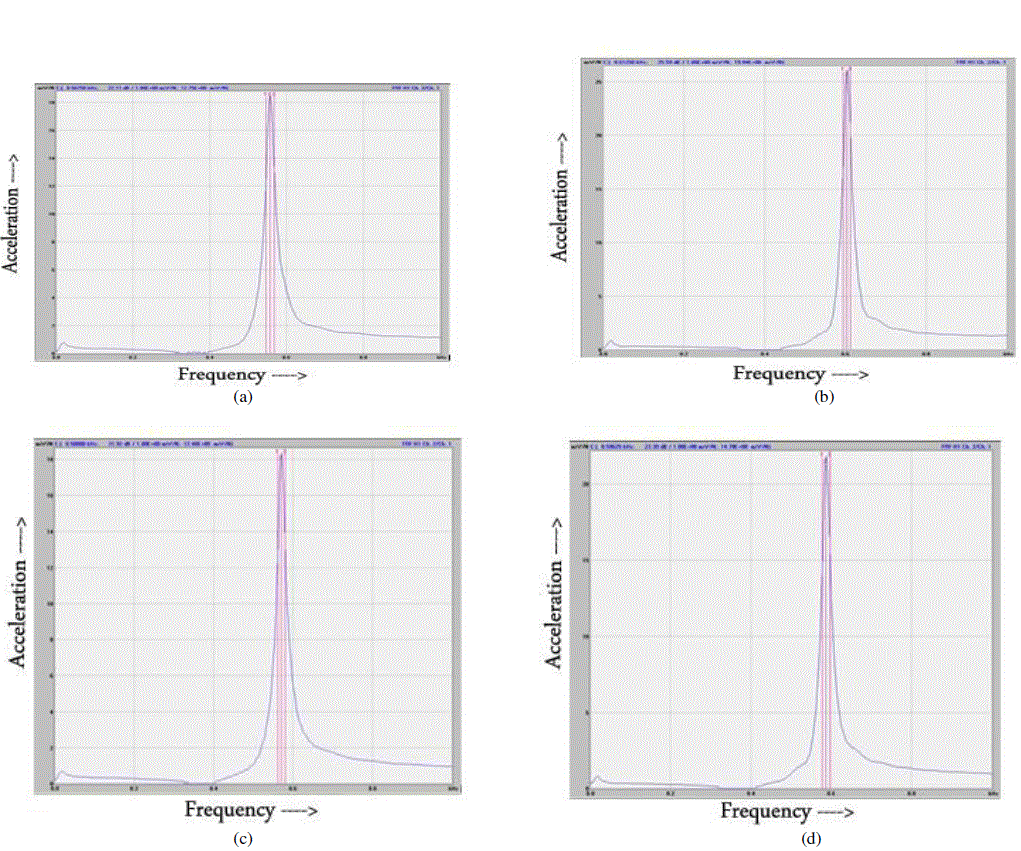 |
| It can be seen from the test results of Gr-Ep and Gr-Ep with Ci powder that there is a considerable increase in modal damping in Gr-Ep with Ci powder specimens. The comparison is shown in Fig. 8. |
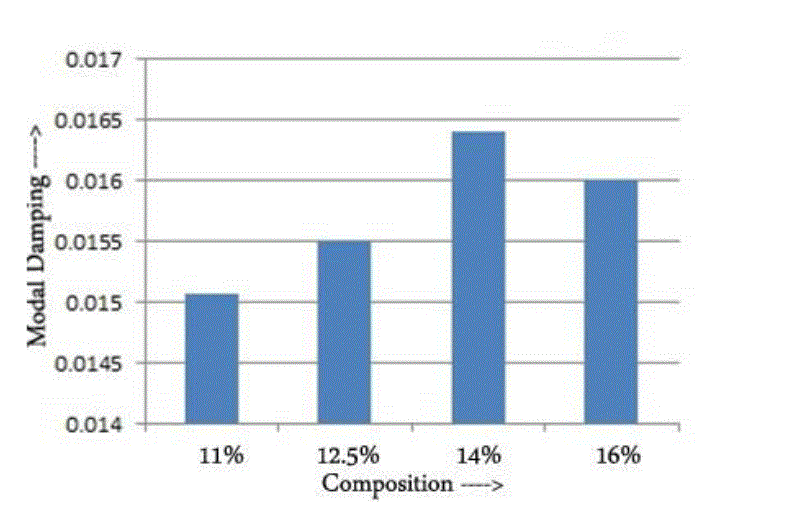 |
V. CONCLUSION |
| Vibrational analysis of epoxy specimens has shown that damping is excellent in various specimens tested with different compositions. The tests indicate that the damping property could be tailored into the structure by a proper selection of the granite aggregate distribution and percentage of resin content. From the tests, it was observed that Granite Epoxy specimen with 12.5% resin content has excellent damping compared to other specimens containing different resin percentages. It has a damping ratio which is around 5 times more than cast iron. Also, it can be concluded from the vibration tests on Granite Epoxy with CI powder, that addition of CI powder to Gr-Ep composites increases the damping properties by a considerable amount. |
References |
|